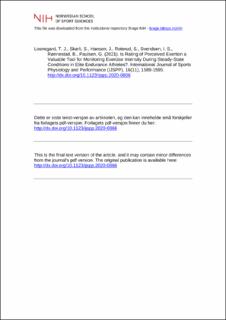| dc.contributor.author | Losnegard, Thomas Johansen | |
| dc.contributor.author | Skarli, Sondre | |
| dc.contributor.author | Hansen, Joar | |
| dc.contributor.author | Roterud, Stian | |
| dc.contributor.author | Svendsen, Ida S. | |
| dc.contributor.author | Rønnestad, Bent | |
| dc.contributor.author | Paulsen, Gøran | |
| dc.date.accessioned | 2021-11-23T08:34:21Z | |
| dc.date.available | 2021-11-23T08:34:21Z | |
| dc.date.created | 2021-09-01T10:12:14Z | |
| dc.date.issued | 2021 | |
| dc.identifier.citation | International Journal of Sports Physiology and Performance (IJSPP). 2021, 16(11), 1589-1595. | en_US |
| dc.identifier.issn | 1555-0265 | |
| dc.identifier.uri | https://hdl.handle.net/11250/2830883 | |
| dc.description | Dette er siste tekst-versjon av artikkelen, og den kan inneholde små forskjeller fra forlagets pdf-versjon. Forlagets pdf-versjon finner du her: https://doi.org/10.1123/ijspp.2020-0866 / This is the final text version of the article, and it may contain minor differences from the journal's pdf version. The original publication is available here: https://doi.org/10.1123/ijspp.2020-0866 | en_US |
| dc.description.abstract | Purpose: Rating of perceived exertion (RPE) is a widely used tool to assess subjective perception of effort during exercise. The authors investigated between-subject variation and effect of exercise mode and sex on Borg RPE (6–20) in relation to heart rate (HR), oxygen uptake (VO2), and capillary blood lactate concentrations. Methods: A total of 160 elite endurance athletes performed a submaximal and maximal test protocol either during cycling (n = 84, 37 women) or running (n = 76, 32 women). The submaximal test consisted of 4 to 7 progressive 5-minute steps within ∼50% to 85% of maximal VO2. For each step, steady-state HR, VO2, and capillary blood lactate concentrations were assessed and RPE reported. An incremental protocol to exhaustion was used to determine maximal VO2 and peak HR to provide relative (%) HR and VO2 values at submaximal work rates. Results: A strong relationship was found between RPE and %HR, %VO2, and capillary blood lactate concentrations (r = .80–.82, all Ps < .05). The between-subject coefficient of variation (SD/mean) for %HR and %VO2 decreased linearly with increased RPE, from ∼10% to 15% at RPE 8 to ∼5% at RPE 17. Compared with cycling, running induced a systematically higher %HR and %VO2 (∼2% and 5%, respectively, P < .05) with these differences being greater at lower intensities (RPE < 13). At the same RPE, women showed a trivial, but significantly higher %HR and %VO2 than men (<1%, P < .05). Conclusions: Among elite endurance athletes, exercise mode influenced RPE at a given %HR and %VO2, with greater differences at lower exercise intensities. Athletes should manage different tools to evaluate training based on intensity and duration of workouts. | en_US |
| dc.language.iso | eng | en_US |
| dc.subject | blood lactate concentration | en_US |
| dc.subject | exercise mode | en_US |
| dc.subject | heart rate | en_US |
| dc.subject | maximal oxygen uptake | en_US |
| dc.title | Is Rating of Perceived Exertion a Valuable Tool for Monitoring Exercise Intensity During Steady-State Conditions in Elite Endurance Athletes? | en_US |
| dc.type | Peer reviewed | en_US |
| dc.type | Journal article | en_US |
| dc.description.version | acceptedVersion | en_US |
| dc.source.journal | International Journal of Sports Physiology and Performance (IJSPP) | en_US |
| dc.identifier.doi | 10.1123/ijspp.2020-0866 | |
| dc.identifier.cristin | 1930336 | |
| dc.description.localcode | Institutt for fysisk prestasjonsevne / Department of Physical Performance | en_US |
| cristin.ispublished | true | |
| cristin.fulltext | postprint | |
| cristin.qualitycode | 1 | |
